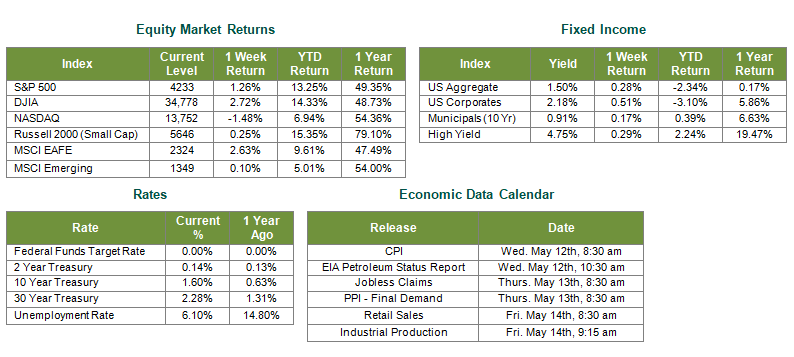
Last Week’s Markets in Review: Assessing the Growth Potential of Small Companies

Global equity markets finished higher for the week. In the U.S., the S&P 500 Index (S&P 500) reached record highs and closed the week at a level of 4,233, representing a gain of 1.26%, while the Russell Midcap Index moved 0.69% higher last week. Meanwhile, the Russell 2000 Index, a measure of the Nation’s smallest publicly traded firms, returned 0.25% over the week. International equity performance was also positive as developed and emerging markets returned 2.63% and 0.10%, respectively. Finally, the 10-year U.S. Treasury yield ticked lower, closing the week at 1.60%.
In our update last week, we discussed first-quarter earnings and the generally positive results thus far. Little has changed in this regard since our previous update as S&P 500 constituents, typically U.S. large-cap companies, continue to impress in terms of their earnings and revenues. However, we’d like to direct your attention to another area of the market, U.S. small-cap companies. To help differentiate large and small cap stocks, the market capitalization is typically above $8 billion and below $2 billion, respectively. Small-caps don’t necessarily draw the same media attention as their larger counterparts during earnings season. However, in general, small-caps are surprising to the upside at a higher aggregate rate thus far in 2021. We’ll use the Russell 2000 Index as a proxy for U.S. small-cap stocks for these purposes. According to Bloomberg, as of May 7, 2021, with over 70% of the Russell 2000 Index companies reporting first-quarter results, actual earnings are 32.4% above estimates, and revenues are 5.3% above estimates. These results compare to S&P 500 members, which recorded earnings and revenues above estimates of 22.9% and 3.8%, respectively. In addition, forward earnings revisions are increasing at a higher rate for small-cap companies when compared to large-cap companies.
If strong vaccination rates in the U.S. and solid earnings reports are bolstering the stocks in the S&P 500, the same can be said to support the outlook for the stocks of smaller companies. In addition, we would point out other tailwinds that support the investment potential of small-cap stocks. First, the general composition of broad-based small-cap indexes leans towards the economy’s more cyclical sectors. Cyclical sectors had typically performed well when economic growth was strong, as it is currently coming out of the COVID-19 induced recessionary period in 2020. Next, relating to our first point, an infrastructure bill out of Washinton will likely act as a tailwind for certain small-cap companies. While there will be much debate between Democrats and Republicans on the amount, scope, and funding of the infrastructure spending bill, we believe, at this time, that the common ground found between the two parties will likely favor domestic, cyclicly sensitive industries in the final iteration of the bill, which may come as early as this summer.
Finally, small-cap valuations remain attractive, even in the face of an impressive run over the last 6+ months. Small-caps look more favorable in Price-to-Book, Price-to-Sales, and particularly Price-to-Earnings (P/E) measures compared to large-caps. As it stands, the Russell 2000’s forward Price-to-Earnings (P/E) ratio, which measures current price over future earnings estimates, is 32% below the index’s 10-year average. For comparison, the S&P 500 currently trades nearly 20% above the 10-year average on a forward P/E basis. This number has come down considerably as earnings have climbed. Still, the significant disparity, along with the tailwinds previously mentioned, merits small-cap stocks within diversified growth portfolios, in our opinion.
When reviewing investment opportunities, investors have a wide array of options outside of a traditional indexing strategy to capture exposure to small-cap companies. This review may include looking for investments that offer exposure to certain factors that may outperform in different market environments. Factors may consist of Growth, Value, Momentum, and Quality, to name a few. In addition, identifying individual companies with attractive attributes can help produce excess returns over the associated benchmark.
It’s essential to keep in mind that a level of risk will accompany allocations to such an area of the stock market and may not be appropriate for all investors. As such, we encourage investors to stay disciplined and work with experienced financial professionals to help build and manage the asset allocations within their portfolios consistent with their objectives, timeframe, and tolerance for risk. Best wishes for the week ahead!
Sources for data in tables: Equity Market and Fixed Income returns are from JP Morgan as of 5/7/21. Rates and Economic Calendar Data from Bloomberg as of 5/7/21. International developed markets measured by the MSCI EAFE Index, emerging markets measured by the MSCI EM Index, U.S. Large Cap defined by the S&P 500. Sector performance is measured using the GICS methodology.
Disclosures: Past performance does not guarantee future results. We have taken this information from sources that we believe to be reliable and accurate. Hennion and Walsh cannot guarantee the accuracy of said information and cannot be held liable. You cannot invest directly in an index. Diversification can help mitigate the risk and volatility in your portfolio but does not ensure a profit or guarantee against a loss.
Diversification can help mitigate the risk and volatility in your portfolio but does not ensure a profit or guarantee against loss.
Investing in commodities is not suitable for all investors. Exposure to the commodities markets may subject an investment to greater share price volatility than an investment in traditional equity or debt securities. Investments in commodities may be affected by changes in overall market movements, commodity index volatility, changes in interest rates or factors affecting a particular industry or commodity.
Products that invest in commodities may employ more complex strategies which may expose investors to additional risks.
Investing in fixed income securities involves certain risks such as market risk if sold prior to maturity and credit risk especially if investing in high yield bonds, which have lower ratings and are subject to greater volatility. All fixed income investments may be worth less than the original cost upon redemption or maturity. Bond Prices fluctuate inversely to changes in interest rates. Therefore, a general rise in interest rates can result in the decline of the value of your investment.
Definitions
MSCI- EAFE: The Morgan Stanley Capital International Europe, Australasia and Far East Index, a free float-adjusted market capitalization index that is designed to measure developed-market equity performance, excluding the United States and Canada.
MSCI-Emerging Markets: The Morgan Stanley Capital International Emerging Market Index, is a free float-adjusted market capitalization index that is designed to measure the performance of global emerging markets of about 25 emerging economies.
Russell 3000: The Russell 3000 measures the performance of the 3000 largest US companies based on total market capitalization and represents about 98% of the investible US Equity market.
ML BOFA US Corp Mstr [Merill Lynch US Corporate Master]: The Merrill Lynch Corporate Master Market Index is a statistical composite tracking the performance of the entire US corporate bond market over time.
ML Muni Master [Merill Lynch US Corporate Master]: The Merrill Lynch Municipal Bond Master Index is a broad measure of the municipal fixed income market.
Investors cannot directly purchase any index.
LIBOR, London Interbank Offered Rate, is the rate of interest at which banks offer to lend money to one another in the wholesale money markets in London.
The Dow Jones Industrial Average is an unweighted index of 30 “blue-chip” industrial U.S. stocks.
The S&P Midcap 400 Index is a capitalization-weighted index measuring the performance of the mid-range sector of the U.S. stock market and represents approximately 7% of the total market value of U.S. equities. Companies in the Index fall between S&P 500 Index and the S&P SmallCap 600 Index in size: between $1-4 billion.
DJ Equity REIT Index represents all publicly traded real estate investment trusts in the Dow Jones U.S. stock universe classified as Equity REITs according to the S&P Dow Jones Indices REIT Industry Classification Hierarchy. These companies are REITs that primarily own and operate income-producing real estate.



